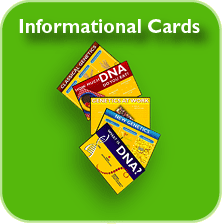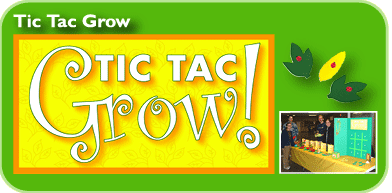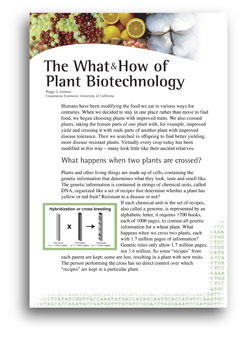

![]()
|
|
Describes the way foods have changed in the past and present using the new genetic tools. Composed of visually striking modules, such as "How Much DNA Do You Eat?", "Classical Genetics", "The New Genetics", "The Changing Face of Corn" and "Controversy". Partial funding provided by the American Society of Plant Biologists. Display available for loan. Please contact Barbara Alonso via email or phone (510-642-1589) to arrange a reservation. |
 |
Click links below to view front/back of cards Classical Genetics | Genetics at Work | How Much DNA Do You Eat? | New Genetics | What is DNA? Partial funding provided by the American Society of Plant Biologists. Cards and accompanying card holder are included with Genetics & Food display reservations. |
|
Describes the importance of plant variation to the future of foods and how and why plants have changed over time. Composed of tactile, visually attractive interchangeable modules, such as "What's Genomics", "Why Is Genetic Diversity So Important to Tomorrow's Foods" and "Are Mutations Involved in Genetic Diversity". Partial funding provided by the American Society of Plant Biologists. Display available for loan. Please contact Barbara Alonso via email or phone (510-642-1589) to arrange a reservation. |
||

Boards, dice, seeds and some foods are available for loan. Used May 2005 at El Dorado Ag Day for third-graders. Prizes for the students were colorful necklaces with pink, yellow, green or black lentils. |
Tic Tac Grow educational game for all ages. Game has a Tic Tac Grow board with plants and corn cobs to use as X's and O's that can be fastened with Velcro to the board. Players roll large colorful dice to determine their question. Numbers are placed on colorful mats that also have plants, containers with seeds or foods. Players are then asked to match the seed with the plant or with the food that is on the matching numbered mat. Level of difficulty of questions can vary with ages of players. Game available for loan. Please contact Barbara Alonso via email or phone (510-642-1589) to arrange a reservation. |
|

|
This interactive activity, mimicking contemporary juice bars, stands alone or can accompany the Foods display. It teaches that DNA and genes are a natural part of our every day lives. Bar includes materials needed for DNA isolation: blender, reagents, colorful beakers and tubes, and an educational handout. Partial funding provided by the American Society of Plant Biologists.
Juice bar available for loan. Please contact Barbara Alonso via email or phone (510-642-1589) to arrange a reservation.
|
| How Much DNA Do You Eat? | ||
 |
This display is augmented with mounted vials of DNA that match the amounts listed next to the food. It is designed to help people understand that they do eat this genetic material in their food. It was designed by Barbara Alonso. Module available for loan. Please contact Barbara Alonso via email or phone (510-642-1589) to arrange a reservation. |
|
| "The What and How of Plant Biotechnology" | ||
 |
This 4-page brochure describes in analogy what happens at the genetic level during classical breeding and genetic engineering. |
|